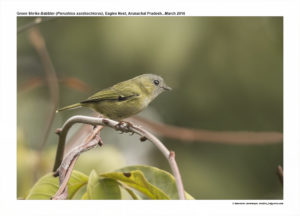
Green Shrike Babbler Pteruthius xanthochlorus
Etymology:
- Pteruthius : Greek word pteron -wing; eruthaino- to dye red { Red Winged}
- Xanthochlorus: Greek word Xanthos – yellow; khloros – green. { Yellowish green}
They belong to the family of Vireo Babblers
Distribution in India: Resident of Western Ghats.
Description: Size of 12–13 cm; 14–15 g. It is a small shrike-babbler with relatively small bill, greyish head, olive upperparts, whitish-grey throat and breast and pale yellow belly. The male of nominate race has forehead to nape slaty mid-grey, with sootier smudge on hindcrown, upperparts are drab olive-green; upperwing is blackish, outer fringes as upperparts, narrow whitish bar along tips of greater coverts, blackish primary coverts. The tail is as upperparts, but outer feathers blackish distally and with narrow white tips; lores, cheek and ear-coverts are mid-greyish, mixed with olive on ear-coverts, throat and underparts are whitish, yellowish-olive wash on lower throat side, behind ear-coverts and along flanks. The iris is dark brown to grey; bill is dark horn, blue-grey on lower mandible; legs are flesh-grey or brown to smoky brown. The female resembles male but has paler grey crown. The juvenile has underparts duller, more olive-brown than adult, grey of head and face not contrasting with upperparts. The race occidentalis has ashy-grey crown and nape and greyer upperparts than nominate; race pallidus has crown colour extending onto mantle, has white eyering, flanks and vent much brighter yellowish-green, wing fringes grey, juvenile male resembles female; race hybrida is like nominate, but with white eyering.
Habitat: It is found in temperate broadleaf and conifer forest, mixed broadleaf-coniferous forest. It is found at 210–3600 m .
Food Habits: It eats Ants, Insect, Worms in summer and Berries and seeds in winter. It forages alone or in a group of 4-5 birds together.
Breeding Habits: The breeding season is April to August. They build the nest, a flimsy, deep purse or cradle, made of fine root fibers and hair-like lichen or moss, bound together. They lay a clutch of 2-4 eggs.